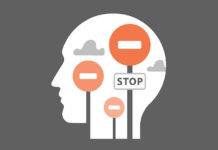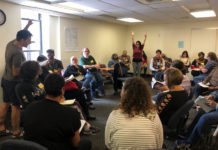Trauma Blocks the Frontal Lobes – “Verbal Physiotherapy” Can Unblock Them
Trauma makes the speech centers of the brain shut down. This is why talking about abuse is so difficult: the words are blocked. If you reclassify trauma effects as trauma-strokes, and you adapt physiotherapy to take this clinical evidence into account, then you come up with Verbal Physiotherapy.
Results of World’s Largest Antidepressant Study Look Dismal
The STAR-D study is by far the largest and most expensive study of antidepressants ever conducted, and it suggests that in real life situations, people taking antidepressants do not do very well. This may be the reason why the results of the main outcome of the STAR-D study have remained buried for so long.
The Cochrane Collaboration Has Failed Us All
The "independent report" that investigated the complaints against Peter Gøtzsche (which included a complaint from E. Fuller Torrey) reveals that they arose in connection with his criticisms of psychiatric drugs. The Cochrane Collaboration's ouster of Gøtzsche betrays a commitment to open-minded science that is vital to serving the public good.
TCI ASIA Pacific: Engaging the Global Mental Health Movement in Dialogue
The "North driving the South" phenomenon has evoked a strong counter response from TCI Asia Pacific and allied organizations (from Africa and Latin America) — especially when we know by now that the western model of psychiatry, based on colonial practices of isolation, seclusion, and coercion, is a failure.
How Well Do Neuroleptics Work?
A recent paper published in Schizophrenia Bulletin reported on a meta-analysis of antipsychotic drugs which found that a significant number of people do not experience a remission of psychotic symptoms. The evidence base suggests that it is time for us to reappraise the effectiveness of these drugs and shift our practice patterns accordingly.
Healthy Guilt and Doing Right By Those We Have Wronged
Therapists tend to view guilt as a toxic emotion. They are often over-sensitized to the psychological effects of too much guilt—of unwarranted guilt—yet often under-sensitized to the interpersonal effects of someone having too little guilt—the absence of guilt when it is warranted. Guilt is one of the primary social emotions that keeps people socially aware.
Fighting the Suppression of Dissent: A Guidebook for Those Who Refuse to Conform
Political, educational, and mental health fields are joining forces in ever more powerful authoritarian rule. The DSM, proclaimed to be a scientific guidebook, is little more than a political instrument used to control undesirable behaviors and experiences. Who will fight for our rights when everybody is tranquilized into conformity?
Healthy Planet/Healthy Mind with Zach Bush, MD
Business as usual — big farming, big pharma and conventional healthcare — is threatening our planet and our very ability to survive as a species. Planetary and human health are at a tipping point. Solutions informed by the science of environmental health, epigenetics and the microbiome, are elegantly simple, but their impact is profound.
Helping Children With Angry Outbursts
Finnish psychiatrist Ben Furman reviews various non-drug therapies for children with aggressive outbursts of anger, including the Kids' Skills approach that he and social psychologist Tapani Ahola developed. These approaches focus on helping children come up with their own ideas for overcoming their problems with the help of family and friends.
We Need To Talk About Self-Care
Self-care the way we’re currently practicing it is unfulfilling in the dangerous way empty carbs are: it requires more and more to sustain itself, further sinking us in isolation and the illusion of self-sufficiency. We are not going to create a society that works for everyone by approaching the task of meeting needs as a zero-sum game. We need each other, because isolation kills.
New Video Series: ‘Parenting Today’
This series of thirty video interviews with leading experts from around the world is designed to help parents better understand how to raise strong, resilient kids and how to deal with the pressures exerted on them by the current dominant “mental disorder” paradigm. We hope that this interview series will provide helpful ideas that you may not be able to get anywhere else. The interviews can be found HERE.
Alternatives to Suicide: Strategies for Staying Alive
For more than 7,300 days of my life, waking up the next morning required me to make a conscious choice to diligently pursue something — anything — other than my impulse to die. Maybe the best teachers of how to avoid suicide will not be the people who are afraid someone else will die, but those of us who can explain how and why we regularly choose to live.
What’s Blocking Progress in Behavioral Healthcare?
It's time to stop blocking progress and give peer-run organizations the same access to the funding streams used by Community Mental Health Centers. There is no reason to give more money to the people who have had all the money all along and can't solve the problems. Open up the competition, and then see what kind of amazing developments occur.
The Science and Pseudoscience of Mental Health Podcast
A growing number of people are seeking an alternative approach to healthcare; one that focuses on achieving optimal well-being rather than symptom management, and views the health of mind, body and spirit as interconnected. The Science and Pseudoscience of Mental Health podcast will explore insights and innovations from this integrative perspective.
Building a Support Network for Peer Workers in NYC
Peer Workers are actively organizing in New York City. This is significant because the mental health system is failing Peer Workers on so many fronts, and it’s long overdue that we start organizing support for ourselves. Peer work started from a social movement on the streets and has ended up a marginalized and co-opted role in a broken system.
Having Empathy Doesn’t Mean That You Also Have Compassion!
There’s a very common, pop-psychology, new-age misconception that conflates being empathic with being caring and compassionate. But some of the most highly empathic people I’ve ever known have been con artists, grifters, unrepentant thieves, cynically manipulative fearmongering politicians, and heartless predators of every kind.
The Decline of Danvers State Hospital
For nearly a century, Danvers was a model asylum in the humanistic treatment of the insane, hosting visitors from all over the world. Patients and their families regarded a stay at Danvers as a positive, healing experience. But after the psychopharmaceutical "revolution," the hospital became a snake pit where the mentally ill went to languish and often die.
A Significant Indigenous Scholarship and Another Antipsychiatry Battle
Why is this scholarship important? Because it will fund, create recognition for, and promote research into violence against Indigenous women. It includes not only what is conventionally seen as violence such as murder, rape, and battery, but also violence perpetrated by institutions, including psychiatry.
Trump Anxiety Disorder Is More Fake News
For many people, the current political situation around the world is intensely frightening and not without cause. Depression and anxiety are on the rise, but we need a social model revolution in order to look at why this is happening. Labels like Trump Anxiety Disorder are merely a way to put people’s concerns in a box and leave them unaddressed.
Why Scientists Should Reconsider Presenting with TED
How many other scientists like me are going to be flagged, publicly reprimanded by TED, for challenging current ways of thinking? Is it even possible to be innovative and follow conventional thinking at the same time? If there are scientists out there with great new ideas, the TED stage may not be the optimal place to state them.
Did You Ever Stop Taking Antipsychotics? – World Survey on Withdrawal
Antipsychotics are big business, professionals are often at a loss as to how to help people going through disturbing experiences, the voices of patients are crowded out of the equation — there are many reasons for the lack of real education and informed consent around antipsychotics. To address this gap in knowledge, we launched a world study on antipsychotic medication withdrawal.
How Doctors Became Such Prolific Drug Dealers
The transformation of normal, unavoidable aspects of life into Medically Treatable Diseases made it not only justifiable, but a moral obligation for potentially everyone to come get euphoria-giving pills. Upstanding, responsible people obey doctor’s orders and do whatever’s medically needed to cure serious illnesses. It was a business model that worked well.
David Foster Wallace: Suicide and the Death of Agency
Today is the 10th anniversary of David Foster Wallace’s suicide. While it’s not fair to build an entire theory on an incredibly complicated issue like suicide around one person, Wallace’s death should challenge the common narratives around suicide — that “mental illness” causes it and that “we can’t ever know why people do it.” Both of these are self-serving platitudes that are simply not true.
Memoirs of a Dissident Psychiatrist
For years I had hoped that psychiatry would free itself from the psychoanalytic doctrine, and when my wish finally came true, my profession went from the frying pan to the fire. My main goal, currently, is to convince professionals as well as the public that most child psychiatric problems can be handled effectively without medication.
Process Oriented Approaches to Altered and Extreme States of Consciousness
When John Herold went to see a Process Work counselor, they talked about how his experience of extreme states had been disruptive in his life, but how these states also had value. The counselor compared John's experience with drinking an entire bottle of Tabasco sauce all at once. Why not instead, the counselor suggested, "try being just a little psychotic all the time?"

































